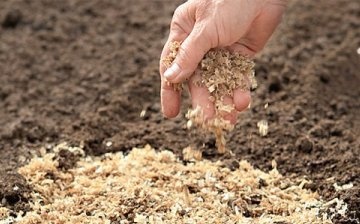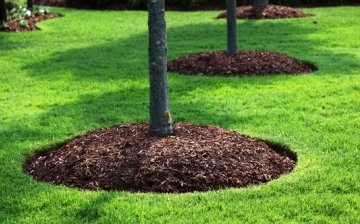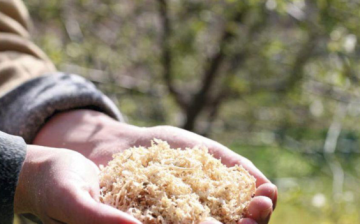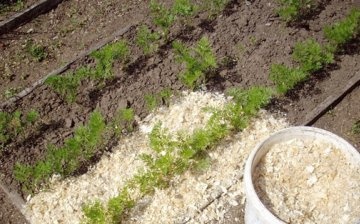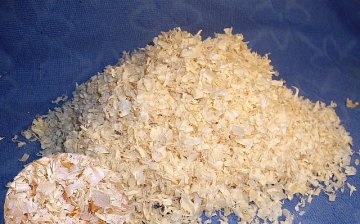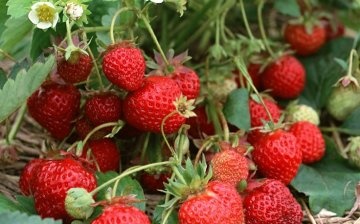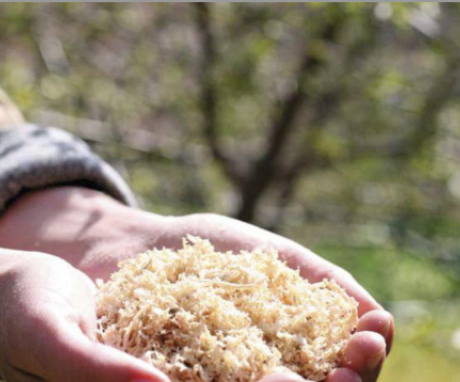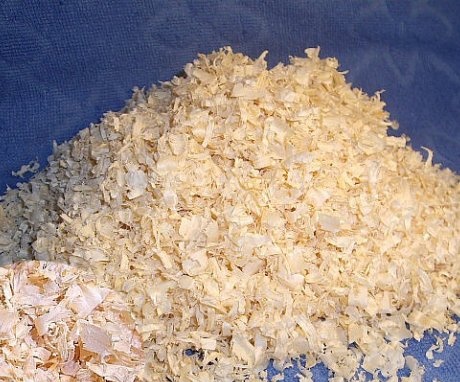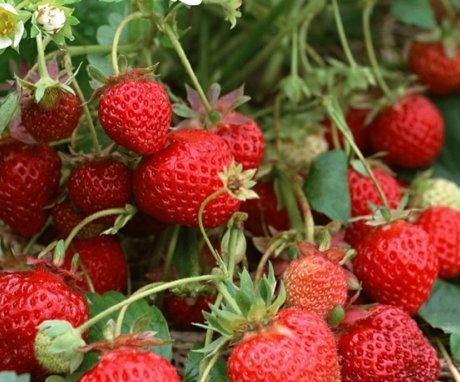Sawdust mulching: technology and advantages of the method
Many gardeners and gardeners have long been practicing such an agricultural technique as mulching. Thanks to him, many different problems are solved on the farm. What does mulching mean and how to do it with sawdust? We will try to answer this question in this article.
Content:
- Mulching as an agricultural technique
- Pros of mulching
- Benefits of sawdust mulching
- Sawdust properties
- Strawberry sawdust mulching technology
Mulching as an agricultural technique
The technology of using mulching, as one of the most effective agricultural techniques, has long been recognized by many amateur gardeners and professionals. Mulching refers to the covering of the upper soil horizon or layer of mulch.
The mulch can be various materials of organic and inorganic origin.
This technique helps to protect the soil and the plants in it from the winter cold, and also helps to improve its structure. To obtain a high yield and maintain the health of the plant organism, it is simply impossible to do without mulching.
In most cases, mulch can be films, fallen autumn leaves and various bulk materials. As for the fallen autumn leaves, this is a good covering material of organic origin. The film type of covering material is also widely used by gardeners; it can be purchased at many retail outlets. Loose mulch is mainly organic materials of various compositions.
In the national economy, the function of free-flowing mulch can be performed by:
- Peat.
- Potato peelings.
- Husk of plants.
- Compost.
- Sawdust and much more.
Pros of mulching
Mulching the soil and plants for the winter is one of the main activities that contribute to the preservation of plant life during the winter frost. Thanks to the use of this agrotechnical method, spring moisture is retained in the soil by the absorbed materials. And as you know, without it, it will be difficult for plants to start growing after a long period of dormancy.
Features of mulching:
- Many gardeners and gardeners use mulch as an excellent fighter against growing weeds. For these purposes, they do not remove the covering material until late spring, as a result of which there is a significant slowdown in the growth of weeds in these areas of the soil.
- Practicing mulching in your dacha farm, you can create additional protection for plant roots from summer overheating, as well as from winter hypothermia. This is very important to ensure the growth of the plant organism during these periods.
- At the same time, mulching helps to protect berry and vegetable crops from soil pollution. So, using a covering material on the soil, you can prevent the contamination of fragile strawberries with soil particles. Thus, the berries will be clean, and they will not need to be thoroughly washed from dirt particles with numerous microorganisms.
- Mulching technology favorably affects the protection of the upper fertile soil layer from spring washout. This is especially important for gardeners, whose plots are not located on flat terrain, but on various kinds of slopes. This will preserve the nutrients in the soil.
- Many organic materials used as mulch provide a favorable environment for soil organisms such as earthworms. By moving and mixing the organic mulch material with the upper soil horizon, good conditions are created for the life of such worms, whose benefits for plant growth are simply invaluable.
- Mulching helps to create a protective layer on the surface of the earth, which prevents the formation of a hard crust on it. And it is known to interfere with the penetration of moisture and air into the lower soil layers, thereby inhibiting the germination and growth of plants available in this area.
- And the most amazing plus of mulching is its use as a decoration for your site. For these purposes, a special decorative mulch is produced, which creates the effect of finding plants on the site during late autumn or early spring.
All of the above advantages, which are ensured by the use of such agrotechnical measures as mulching on the site, can solve many problems with plant growth and facilitate the work of gardeners and gardeners.
Benefits of sawdust mulching
The use of sawdust as mulch has long been used by many plant growing enthusiasts. And this is no coincidence! After all, sawdust mulch has many advantages that allow gardeners to stay on it as a covering material in the winter.
Consider the main advantages of mulching the soil with sawdust:
- Firstly, the use of sawdust mulch is one of the cheapest materials for this technology. For those who live near forest plantations, where there are a lot of dead wood, it is not difficult to prepare sawdust. And if any of the woodworking enterprises is in the neighborhood with you, then having come there you will be generously endowed with this material of any kind.
- Secondly, sawdust, especially conifers, is not a favorable breeding ground for various pathogens. This advantage allows sawdust to be considered a good sterile material. Fresh sawdust repels many pests of agricultural crops, they are especially unpleasant for snails and slugs. The rough surface of the sawdust is unbearable for their movement.
- Thirdly, using sawdust materials as mulch on your site, you contribute to the saturation of the soil layer with spring moisture. Especially the amount of this moisture increases when using the smallest sawdust. Providing the soil with these hygroscopic properties is favorable for early plant growth. In addition, the small sizes of sawdust quickly become saturated not only with moisture, but also solutions of liquid fertilizers, while they themselves decompose faster. Thus, the use of sawdust not only preserves the plants during the winter cold, but also contributes to the saturation of the soil with moisture.
Sawdust mulching of the soil layer is one of the best heat-insulating materials. Many of us insulate our summer cottages and buildings with sawdust.
Wood waste not only serves as a good insulation material, but also promotes the passage of air through itself, which is necessary for the growth and development of the plants below it.
So, having considered the main advantages of sawdust mulch, we can come to the conclusion that its use solves many problems in the agricultural technology of cultivating various plants. In addition, the technology for using this type of mulch is very simple and affordable.
Sawdust properties
By its structure, sawdust mulch can be of different sizes, composition and production time. In this regard, it may have some differences in properties. Based on this fact, each type of sawdust mulch should be used for its intended purpose.
Many users of this material have noticed as mulching that semi-rotten sawdust is the most favorable. They are usually gray-brown in color and are also called "horse" sawdust. This name is associated with the place of their lying, usually they are taken from places where horses are kept (stable), where they used to play the role of bedding. Recycling sawdust in this way makes their presence on the farm mandatory. In structure, they are of medium size, due to which they do not cake and ensure the penetration of moisture and air into the lower layers of the earth.
Do not use sawdust that is very small in size on the beds, as they can cake into lumps and form a crust on the soil surface.
Using large-sized sawdust as mulch contributes to the formation of a very thick and rather loose sawdust layer on the surface of the earth. It is quite difficult to compact such a layer, as the plant stems in it may suffer. Therefore, the structure of sawdust mulch directly depends on the age of the sheltered plants: the finer the structure of the sawdust, the younger the sheltered plant organisms. Larger sawdust should not be thrown away, considering them unnecessary material. They are well suited for sheltering ornamental shrubs or fruit trees growing near the house for the winter.
Freshly prepared sawdust mulch is ideal for sheltering strawberry plants and strawberry... The emanating smell of fresh wood is unpleasant and acts as a deterrent to many types of insect pests of the vegetable garden and garden. For example, using wood waste from coniferous trees in carrot beds as mulch, you can forget about such a pest as carrot fly, because its coniferous aroma is very unpleasant. Sawdust also protects the berries lying on them from soil dirt.
Strawberry sawdust mulching technology
For strawberries, sawdust is well suited as a covering material. Technology mulching them in the beds very simple. First you need to weed all the beds from the weeds on them. Next, you need to spread layers of newsprint between the strawberry bushes.
Typically, newspapers are spread in two layers to provide extra strength. These layers are covered with prepared sawdust, up to five centimeters thick. Mulching is over. Now the beds will not only be protected from the winter cold, saved from the loss of spring moisture, but also will not need additional weeding.
More information can be found in the video.



